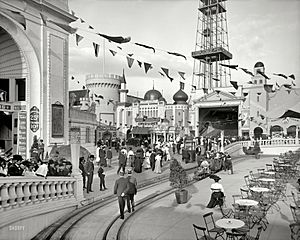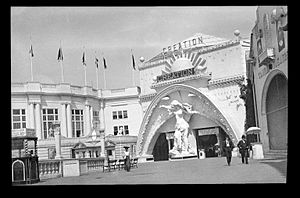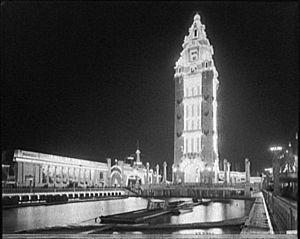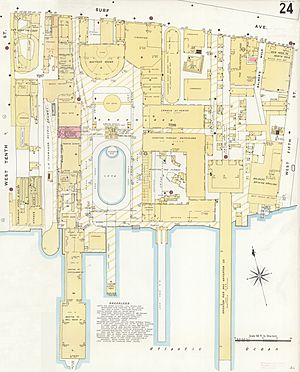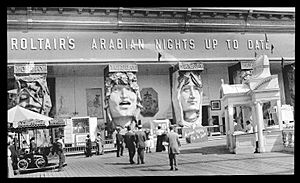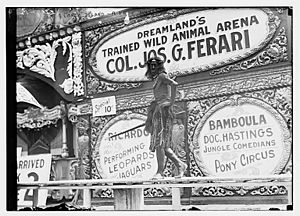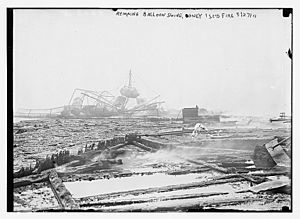Dreamland (Coney Island, 1904) facts for kids
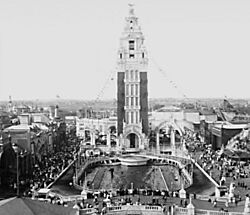
Seen in 1907
|
|
| Location | Coney Island, Brooklyn, New York, United States |
|---|---|
| Coordinates | 40°34′37″N 73°58′44″W / 40.577°N 73.979°W |
| Status | Closed |
| Opened | May 15, 1904 |
| Closed | May 27, 1911 |
| Owner | William H. Reynolds |
Dreamland was a famous amusement park in Coney Island, Brooklyn, New York City. It was open from 1904 to 1911. Dreamland was the last of three big parks built in Coney Island. The other two were Steeplechase Park and Luna Park.
| Top - 0-9 A B C D E F G H I J K L M N O P Q R S T U V W X Y Z |
Building Dreamland
The park was started by William H. Reynolds. He was a former state senator and a successful real estate developer. He wanted Dreamland to be a rival to Luna Park. Luna Park had opened nearby in 1903.
Reynolds planned Dreamland to be more elegant and refined. It was different from Luna Park, which was known for its many rides and loud atmosphere.
Reynolds bought a large piece of land, about 15 acres. He used other people to buy the land so no one would know his real plan. Once he owned the land, he used his political power. He had West Eighth Street torn down to make the park even bigger. Today, the park's old location is near the West Eighth Street subway station. It is also close to the New York Aquarium.
What Was Inside Dreamland
Dreamland opened on May 15, 1904. It was designed to be bigger and grander than Luna Park. Dreamland had a huge central "Tower." It also had one million electric light bulbs. These lights lit up and outlined all the buildings. This was four times more lights than Luna Park had.
Dreamland offered fancy entertainment and big shows. These shows often taught lessons about right and wrong. Examples included "The End of the World" and "Feast of Beshazzar." The park also had beautiful white buildings. There were some educational exhibits mixed with the fun rides.
Some of Dreamland's cool attractions were:
- A railway called Coasting Through Switzerland. It went through a pretend Swiss mountain area.
- Fake Venetian canals with gondolas (boats).
- A "Lilliputian Village" with three hundred people with dwarfism.
- A Filipino village showing Igorot people in traditional clothes.
- A firefighting show where two thousand people acted out putting out a big fire. This happened every half-hour.
Many of Dreamland's rides were similar to those at Luna Park. There were two Shoot-the-Chutes rides. These water rides could handle 7,000 riders every hour. There was also a pretend submarine ride.
The side shows were run by the Dicker family. They also owned the hotel next to the park. One special exhibit showed baby incubators. These were new machines that helped premature babies survive. The Dicker family had triplets who were born too early. Hospitals did not allow incubators yet. So, the babies were cared for and shown in the side show. Two of the triplets grew up to live full lives.
For publicity, the park had famous Broadway actress Marie Dressler in charge of the snack stands. Young boys dressed as little imps sold peanuts and popcorn. Dressler was said to admire Captain Jack Bonavita. He was a brave lion tamer with one arm. Bonavita lost his arm after a lion scratched his hand. The infection spread, and his arm had to be removed.
The Fire That Destroyed Dreamland
Even with its many attractions, Dreamland struggled to compete with Luna Park. Luna Park was managed better. For the 1911 season, Dreamland made many changes. Samuel W. Gumpertz became the park's new leader. The buildings, once all white, were repainted in bright colors.
On the night before opening day, May 27, 1911, an attraction called Hell Gate was being repaired. Workers were fixing a leak with hot tar. Around 1:30 a.m., the light bulbs lighting the area exploded. This was probably due to an electrical problem. In the dark, a worker accidentally kicked over a bucket of hot pitch. Soon, Hell Gate was on fire.
The fire quickly spread through the park. The buildings were made of wood frames covered with a plaster mixture. Both materials caught fire very easily. Fires were a common problem in Coney Island amusement parks. A new high-pressure water station had been built nearby. But on that night, it did not work. There was some water, but not enough to stop the huge fire. The Dicker family's hotel next to the park also burned down.
The park was in chaos as it burned. Captain Bonavita tried to save his big cats. The flames were all around him. Some terrified animals escaped, but about 60 animals died. A lion named Black Prince ran into the streets. Police had to shoot him to protect the crowds.
By morning, the fire was out. Dreamland was completely destroyed. It was never rebuilt. Early newspaper reports said the incubator babies had died. But later, the paper corrected this. All the babies were saved. Police Sergeant Frederick Klinck rescued many of them. He went into the burning building several times.
Almost ten years after the fire, William H. Reynolds owned most of Dreamland's bonds. This meant he would make a lot of money from the land. He used his political connections. He convinced New York City to buy the land where Dreamland once stood. The city bought the land for $1.8 million. It was valued at $1.5 million.
Dreamland in Books and Movies
Film
- A fictional Dreamland appears in Disney's 2019 movie Dumbo. The movie shows an electrical fire. But the film's story is not exactly like the real events.
Literature
- Kevin Baker wrote a historical novel called Dreamland. It describes life in New York City when the park existed. The book talks about politics and social conditions. Dreamland is a main setting in the book. It also describes the fire.
- Dutch writer Arthur Japin's novel De grote wereld (The Big World) is partly set in Dreamland. It is about two people with dwarfism.
- American author Alice Hoffman writes about Dreamland in her 2014 novel "The Museum of Extraordinary Things." The book is set in New York City in the early 1900s. The Dreamland fire is part of the story.
Music
- Tom Waits wrote the song "Tabletop Joe." The song's character is part of a side show. He becomes rich and famous at Dreamland.
- Brian Carpenter wrote a play and songs for his album Dreamland. It tells a story about a gold miner who works in Dreamland's side shows.
Podcasts
- The August 28, 2019, episode of "The Memory Palace" by Nate DiMeo is about Dreamland.
Images for kids
-
Entrance to the exhibit "Creation," which showed the first 6 days in the Book of Genesis.
See also
 In Spanish: Dreamland (parque de atracciones) para niños
In Spanish: Dreamland (parque de atracciones) para niños


